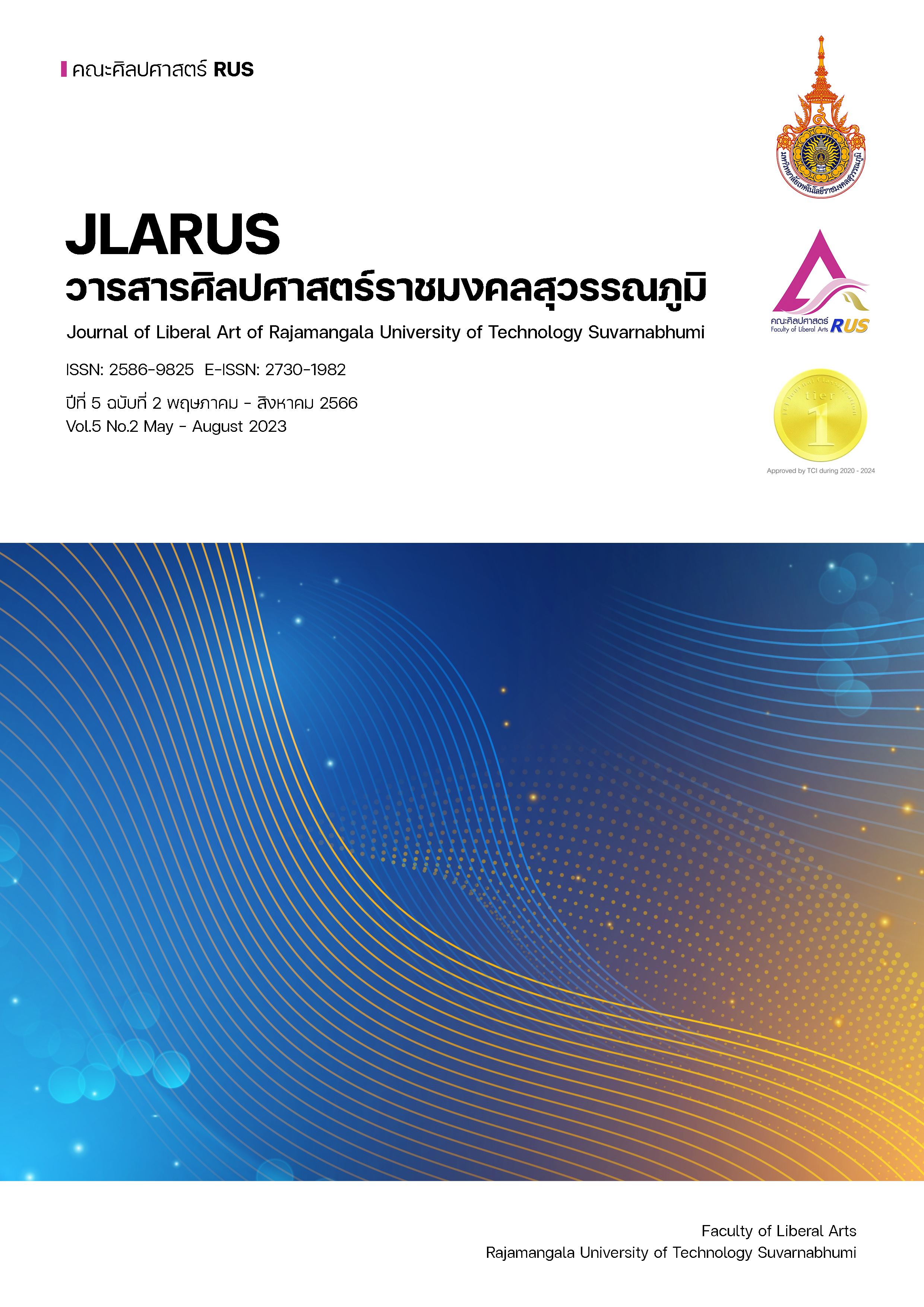A FINANCIAL RATIOS ANALYSIS OF PERFORMANCE ASSESSMENT IN THE AIRLINE BUSINESS
Main Article Content
Abstract
The coronavirus disease 2019 outbreak was considered a global pandemic. Even though so many airlines were most impacted by the outbreak, some of them were least impacted, regardless of the same situation they were confronting. Therefore, the purpose of this study aimed to 1) study the business performances of the selected airlines and 2) analyze and compare financial ratios for studying the business performances of selected airlines. The subjects of the study were selected carefully with the criteria that the financial situations of the subjects had to be different. Therefore, the analysis can present clear results and show how they operated their businesses differently. The first airline selected was the airline that filed for bankruptcy in 2020 or ‘Colombia’s flag carrier’ and the second airline was the airline that could continue its business in 2020 (despite the unforeseen pandemic in 2020) or ‘Japan’s flag carrier’. The study can be categorized into qualitative analysis and used descriptive method to present its result. It used financial ratios as a tool to analyze and focused on 5 different aspects of business performance. These 5 aspects are liquidity, solvency, profitability, operational efficiency, and passenger capacity utilization of the airlines. The financial data were subtracted from the annual reports of the airlines. The time period to study was selected 5 years prior to the pandemic.
The results of the research showed that 1) Japan’s flag carrier had higher liquidity; 2) Japan’s flag carrier had more solvency; 3) Japan’s flag carrier had more profitability; 4) Japan’s flag carrier was more efficient, except the efficiency of debt collection from debtors, and 5) Colombia’s flag carrier had more passenger capacity utilization than Japan’s flag carrier
Article Details

This work is licensed under a Creative Commons Attribution-NonCommercial-NoDerivatives 4.0 International License.
References
ตลาดหลักทรัพย์แห่งประเทศไทย. (2563). เทคนิคการวิเคราะห์งบการเงินบริษัทจดทะเบียน. สืบค้น 24 ธันวาคม 2563. จาก https://www01.bualuang.co.th/le/help/kw/ebook004.pdf.
ทักษิณา แสนเย็น, วรวุฒิ เว้นบาป, วีระพันธ์ ช่วยประสิทธิ์, กุลธวัช ศรายุทธ, และ อาภาภรณ์ หาโส๊. (2563). บทวิเคราะห์การรับมือโรคโควิด-19: ผลกระทบต่ออุตสาหกรรมการบิน. วารสารสหวิทยาการมนุษยศาสตร์และสังคมศาสตร์, 3(2), 209-220.
ปรียานุช กิจรุ่งโรจน์เจริญ. (2558). การบริหารเงินทุนหมุนเวียน. วารสารสารสนเทศ, 14(2), 7-19.
พจน เจิมสวัสดิ์. 2563. ความสำคัญของรายได้เสริมนอกเหนือจากบัตรโดยสาร (Ancillary Revenue) ต่อรายได้ขอสายการบิน. สืบค้น 28 สิงหาคม 2563. จาก https://www.wingtips.info/ academic-001/.
วิทยาลัยอาชีวศึกษาเชียงราย. (2546). การวิเคราะห์อัตราส่วนทางการเงิน (Financial Ratio Analysis). สืบค้น 19 มกราคม 2564. จาก https://www.cvc.ac.th/cvc2011/external _links.php?links=2089.
วิทยาลัยอาชีวศึกษาเชียงราย. (2546). งบกระแสเงินสด (Statement of Cash Flows). สืบค้น 10 มกราคม 2564. จาก https://www.cvc.ac.th/cvc2011/external_links.php?links =2089.
วิทยาลัยอาชีวศึกษาเชียงราย. (2546). แนวคิดการรายงานทางการเงินและการนำเสนองบการเงิน. สืบค้น 08 มกราคม 2564. จาก https://www.cvc.ac.th/cvc2011/external_links.php ?links=2089.
สุภาวดี ขุนทองจันทร์ และ ทักษธิป ขุนทองจันทร์. (2564). ตัวแปรที่ส่งผลต่ออัตราส่วนการขนส่งของสายการบินต้นทุนต่ำไทยแอร์เอเชีย. วารสารบริหารศาสตร์ มหาวิทยาลัยอุบลราชธานี, 10(2), 141-154.
อังครัตน์ เพรียบจริยวัฒน์. (2554). การวิเคราะห์งบการเงิน. (พิมพ์ครั้งที่ 6). กรุงเทพมหานคร: ศูนย์ส่งเสริมการพัฒนาความรู้ตลาดทุน ตลาดหลักทรัพย์แห่งประเทศไทย.
Cheng, L.. (2013) Report on Financial Analysis of Easy Jet and Ryan Air Financial Comparison. (2013). Retrieved December 25, 2022. from https://www.aca demia.edu/23846034/Report_on_Financial_Analysis_of_Easy_Jet_and_Ryan_Air_Financial_Comparison_Module_Financial_Analysis.
Henry, E., Robinson, T.R., & van Greuning, J. H.. (2021). Financial Analysis Techniques. Retrieved December 30, 2022. from https://www.coursehero.com/file/47832 020/MODULE-6pdf/.
Camilleri, M. A. (2018). Aircraft Operating Costs and Profitability. In Travel Marketing, Tourism Economics and the Airline Product (Chapter 12, pp. 191-204). Cham, Switzerland: Springer Nature.
Michael, G.. (2018). Meet The Most Crowded Airlines: Load Factor Hits All-Time High. Retrieved December 30, 2022. From https://www.forbes.com/sites/Michael Goldstein/2018/07/09/meet-the-most-crowded-airlines-load-factor-hits-all-time-high/?sh=5461c57a54fb.
Mukhtar, H. M.. (2015). Financial Statement Analysis in The Airline Industry: A Comparative Study of Turkish Airlines and Royal Dutch Airlines (ROYAL DUTCH AIRLINES). (thesis). Türkiye, Konya: Selçuk Üniversitesi.
Niklas, H.. (2019). Comparative Performance Analysis of Airline Companies: Evidence from EasyJet and Norwegian During 2014-2018 (Bachelor’s thesis). Estonia, Tallinn: Tallinn University of Technology.
Oum, T. H., Zhang, A., & Fu, X.. (2010). Air Transport Liberalization and Its Impacts on Airline Competition and Air Passenger Traffic. Transportation Journal, 49(4), 371-390.
Rishika, M.. (2021). Reasons why Airline industries are always struggling. Retrieved January 18, 2021. From https://insider.finology.in/business/reasons-why-airlines-indust ry-always-struggling.
Samuel, R. & James, M. (1973). Airline Size, Profitability, Mergers and Regulations. J.AIR L. & COM. 39(2), 167-213.


